1831 Costa Rica 8 Reales
There are 3 pieces in the Heritage ANA auction. One is an 1831-F, another from the rare assayer E, and the third piece unclear because the bottom of the assayer’s initial is cut off by a slightly off center strike. Let’s see if we can figure out what it is!
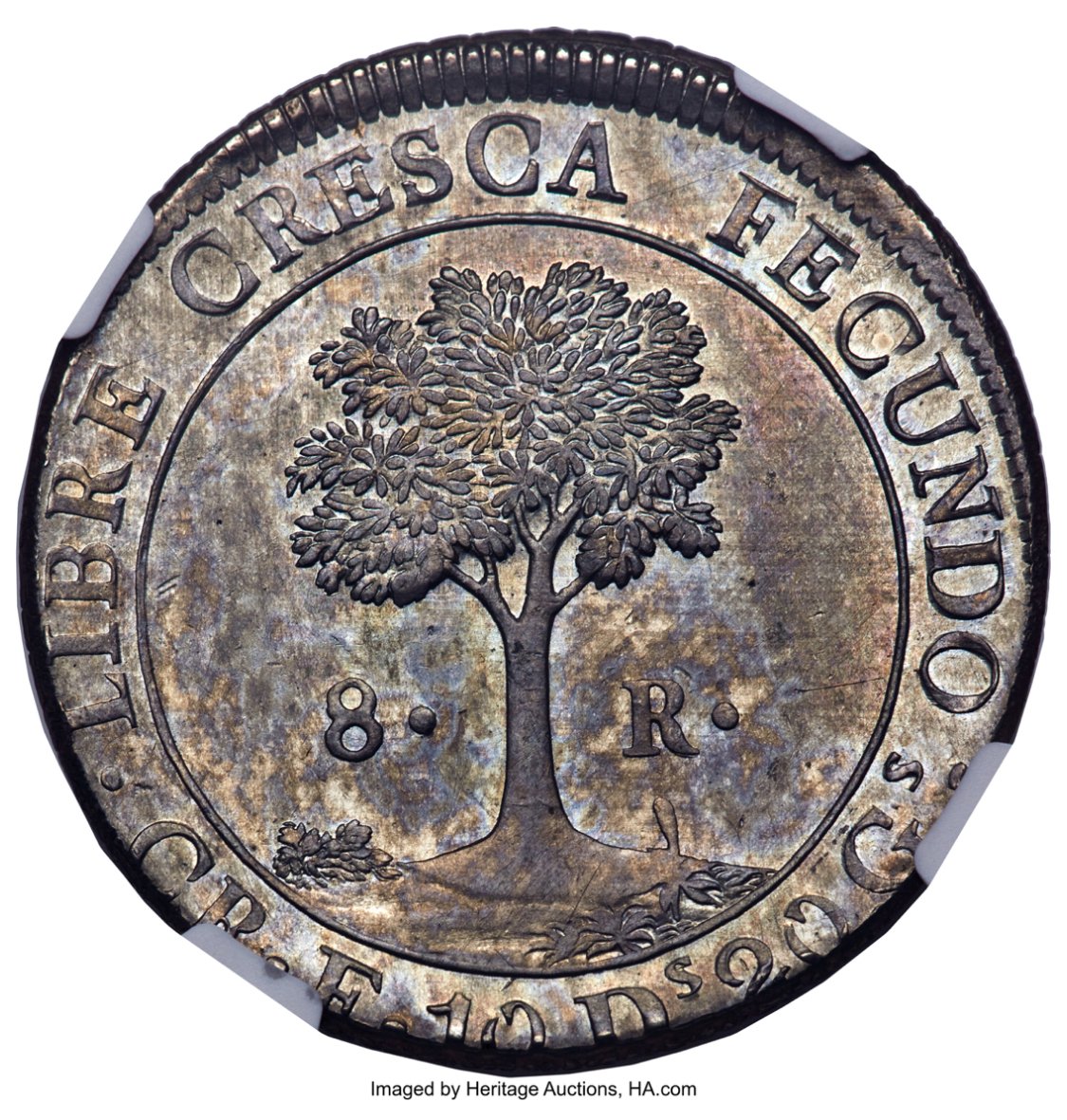
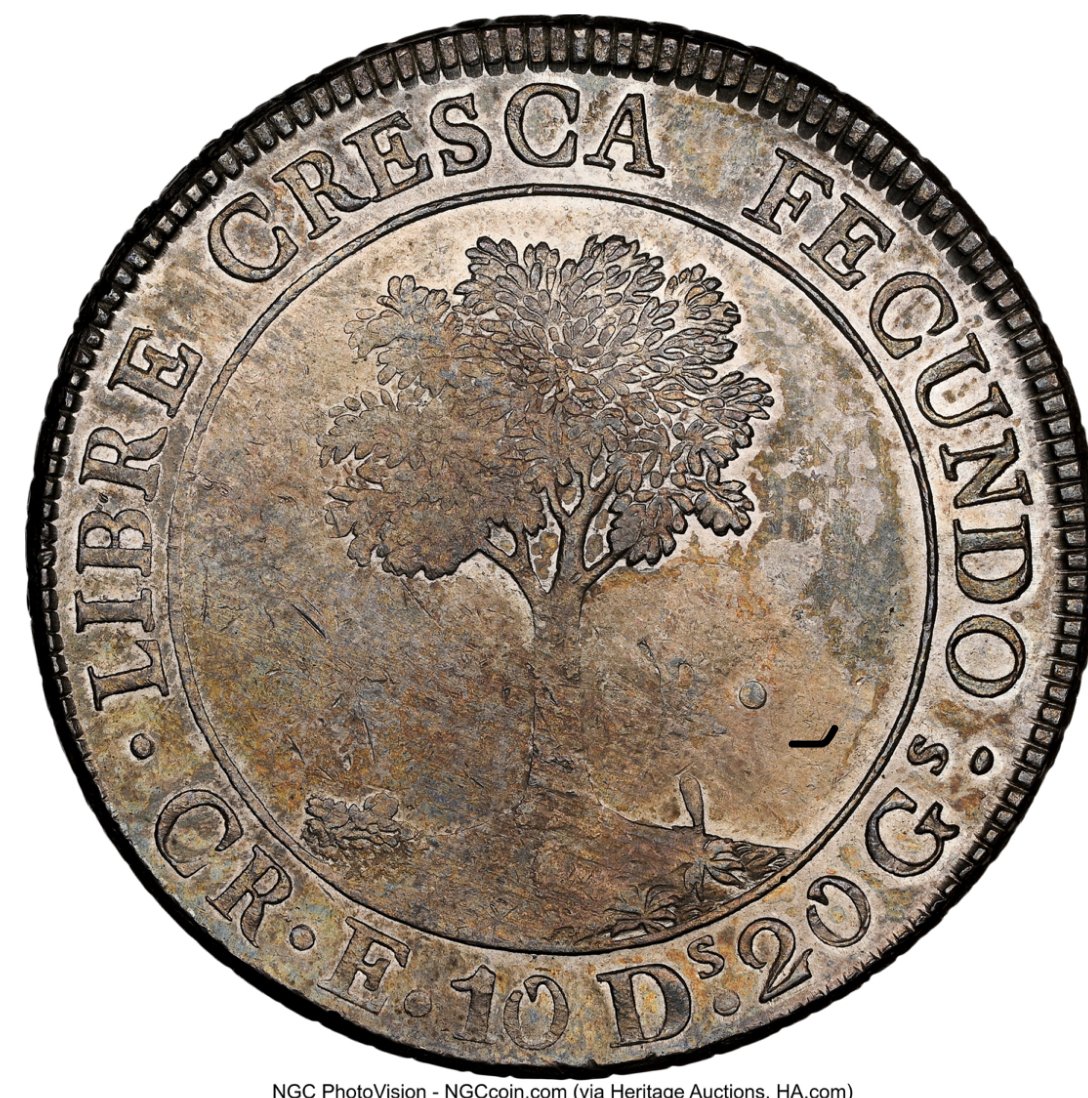
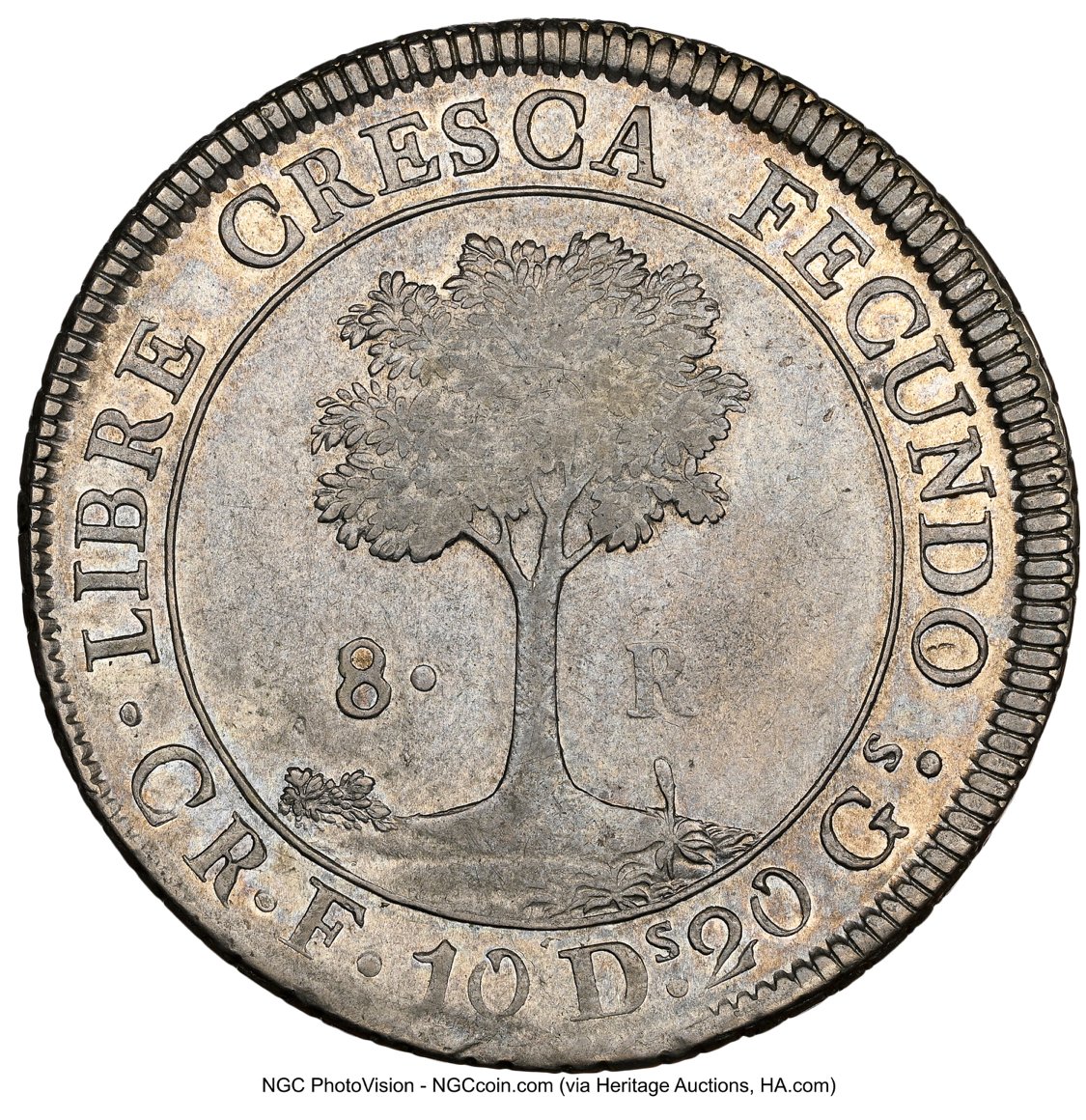
Andy Lustig
Doggedly collecting coins of the Central American Republic.
Visit the Society of US Pattern Collectors at USPatterns.com.
Doggedly collecting coins of the Central American Republic.
Visit the Society of US Pattern Collectors at USPatterns.com.
2
Comments
Looks like an F to me. The middle vertical bar is E is thicker and protrudes further.
I’d vote F unless more than one E assayer punch is known for this year. Which, since it’s very rare, seems unlikely.
I agree, I also think we'd see some part of the upper tip of the lower horizontal leg of the E based on how the other E's look.
Look at the position of the letters R and E in CRESCA.
Also consider the possibility that there were other reverse dies used in 1831.
Doggedly collecting coins of the Central American Republic.
Visit the Society of US Pattern Collectors at USPatterns.com.
Different dies, sure. But they would likely use a standard set of master punches.
A standard set of master punches in the period would include only the central design. The lettering would be punched separately. It thus must be the same die as the E assayer, as the spacing is the same.
…except that assayer punch is visibly different from the E punch, and appears very similar to the F punch.
My vote is that at the time the first coin was struck, the die featured an F assayer. It was then repunched with an E assayer. This is supported by a shared spike of die tooling protruding from the base of the inner circle, above the 0 in “10” that is consistent on both the top coin and the E assayer coin - and it appears to have mostly eroded away on the E assayer, indicating a later die state.
Gobrecht's Engraved Mature Head Large Cent Model
https://www.instagram.com/rexrarities/?hl=en
What i meant was that the letter punches were likely created from the same matrix, so the letters would be standard in design regardless of the die. F looks different than E and the assayer initial looks more like the F.
Judging by the initials alone, I’d say it’s an F as well. That was my first conclusion, assuming that there was only one F punch and one E punch. This one looks just like the F punch on the confirmed F coin. The middle section even droops the same way.
I'm BACK!!! Used to be Billet7 on the old forum.
Well, the E and the suspect F are different, therefore, I think is an F.
The coin has a look... not sure- but it looks to be an F without a further in hand look
Experience the World through Numismatics...it's more than you can imagine.
Original image - top
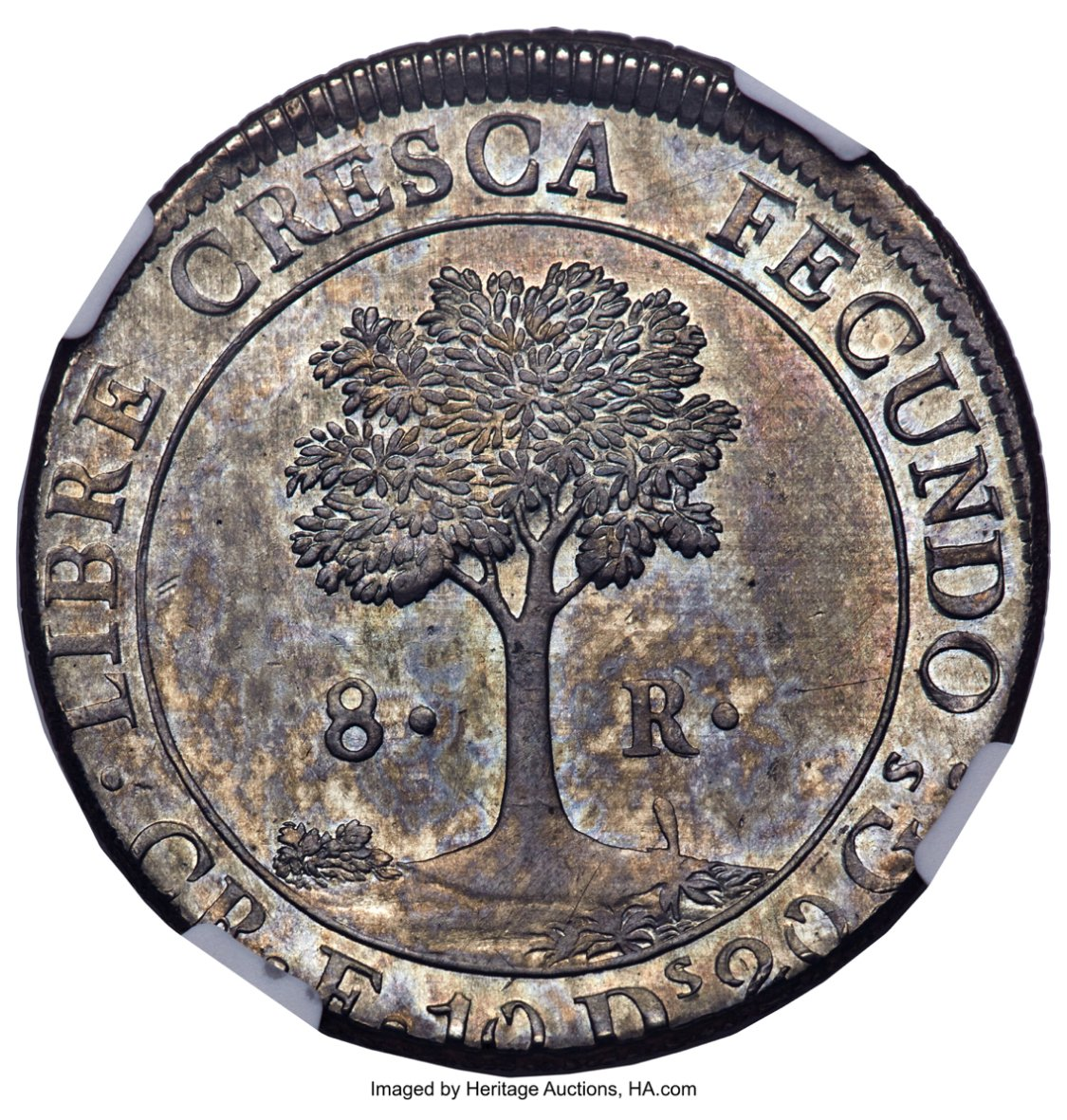
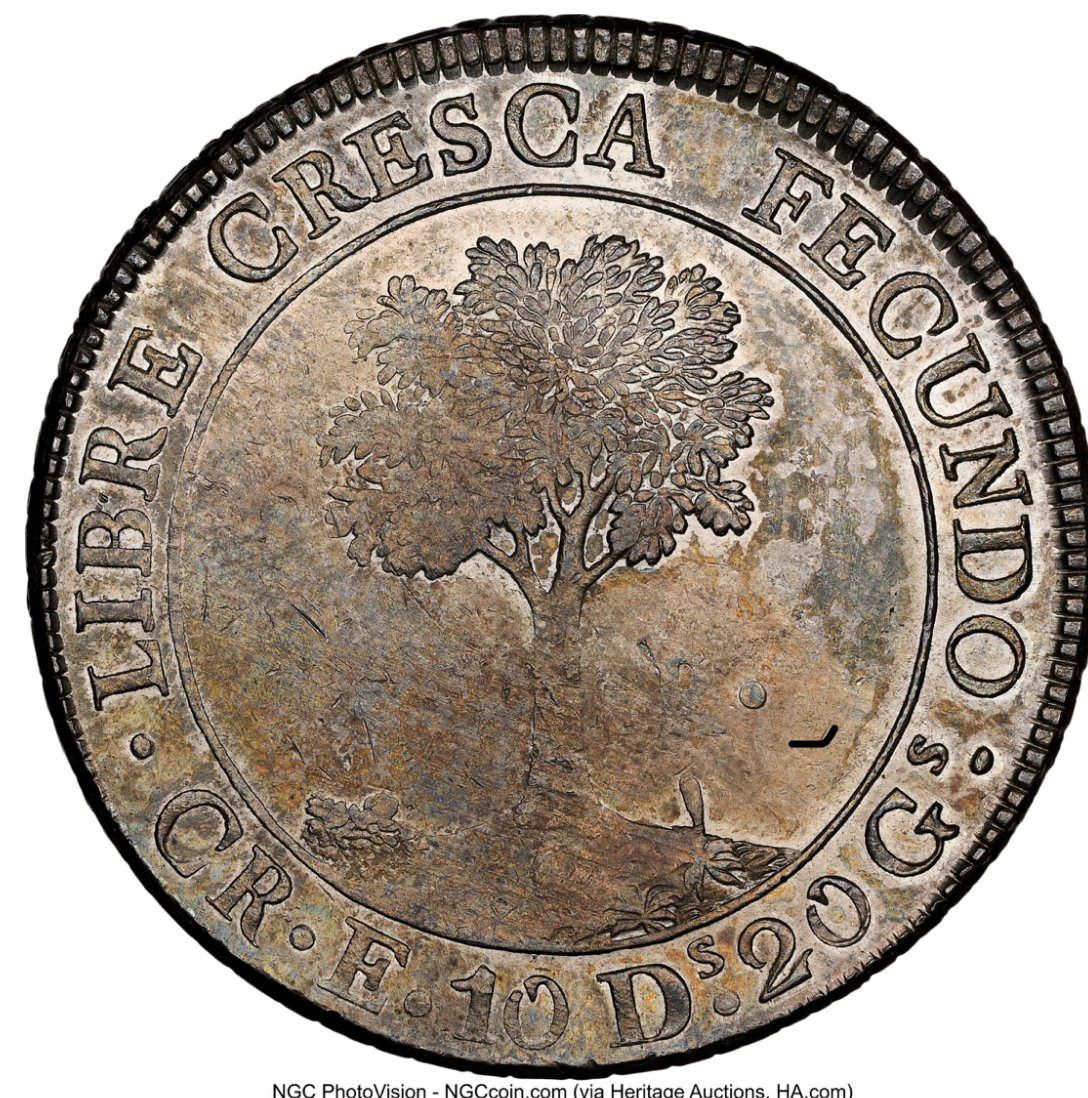
Original image - middle
Here is the second (middle) coin made into a transparency and laid over the first (top) coin
Here is a close up of the area of the assayers initials of the two coins using overlay
Here is the "E" outlined in yellow, which helps to show size difference between the middle branch of E/F
bottom overlay closeup
Look at the die crack going through the top of the E in CRESCA. The mystery coin exhibits the earlier state of the die crack.
Doggedly collecting coins of the Central American Republic.
Visit the Society of US Pattern Collectors at USPatterns.com.
This is a great answer, but I think it’s wrong. There are other cases at this mint in this era where F’s were converted to E’s. Not by repunching them, but by adding a base to the F. It’s not obvious on this die, but it’s possible that it was done. And if that is indeed what was done with this die, the question is if it was done before or after the mystery coin was struck. I would say after, because the look and feel of the coin is very similar to the 31-E’s, and very much unlike the 31-F’s. (The 31-F’s were struck in 1831, typically and maybe always over other coins. The 31-E’s were struck on freshly produced planchets, no sooner than 1838, because that’s when Assayer F lost his job and Assayer E took over.)
Doggedly collecting coins of the Central American Republic.
Visit the Society of US Pattern Collectors at USPatterns.com.
Interesting coin. I did a quick search through the archives for the different assayers and the die with the die crack in the E in CRESCA comes up often and it's an E assayer die.
Except it also looks like it could be on this F15 example below. And again looks to be an F punch shape of the letter. The other F assayers I saw also had some die chips around the assayer and 10 Ds that seems to be missing from the Millenia coin, but I've also seen examples where those chips were not there.
I mean, theoretically, off-planchet (like the Millenia coin) or thinner planchet at the bottom resulting in a weaker strike (like this F15 example) could change the metal flow into the die recesses during the strike that would result in a thinner letter being struck, but I think that's a bit of a stretch.
Well, doesn’t that mostly line up with my hypothesis? I agree that the mystery coin was struck before the die was changed - hence the later die state on the E coin. I don’t think the F was retooled into an E, because the middle bar on the assayer E closely matches that on the other Es in the legend, indicating that it was made from a punch. But either way, what other explanation than a reworked die might there be, given that the spacing in the legend is identical on the mystery die and the E assayer die?
Gobrecht's Engraved Mature Head Large Cent Model
https://www.instagram.com/rexrarities/?hl=en
Mystery coin is an E assayer.
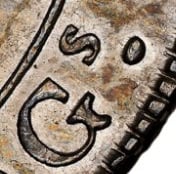
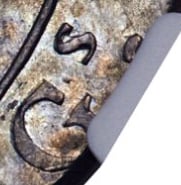
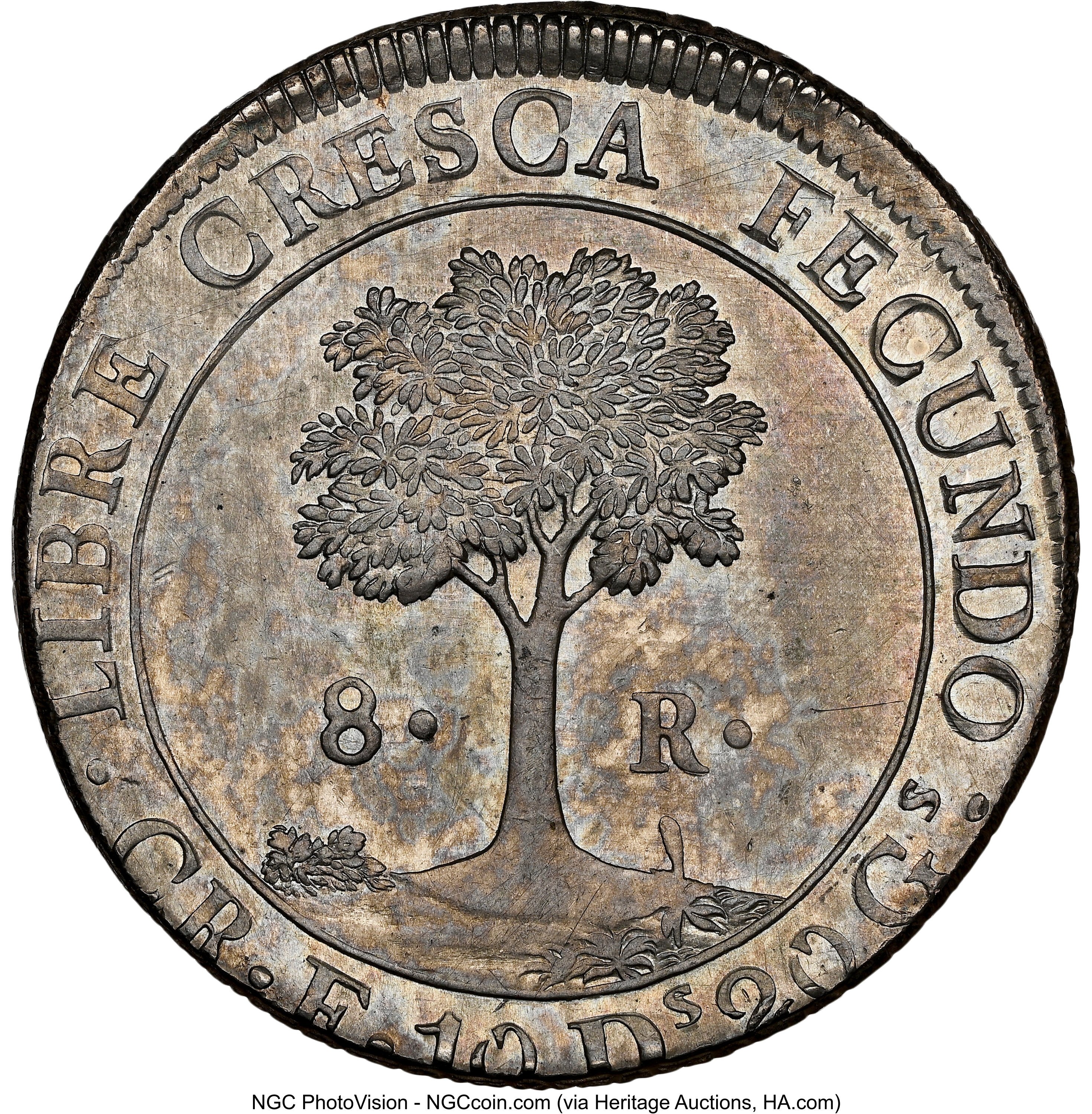
The stop between "20Gs" and "FECUNDO" is oblate in the E coin and the mystery coin; it is round in the F coin:
E Assayer:
Mystery coin:
NCG PhotoVision photographed the mystery coin without the holder prongs obscuring the stop:
Depending on how much gossamer you all wish to dissect, there is a denticle immediately above the A in CRESCA in the E assayer coin and mystery coin; there is a gap in denticles above the A in CRESCA in the F assayer coin.
Makes sense if the E coins came later and both the E coin and the mystery coin show a die crack in the E in CRESCA. Mystery coin looks like a later die state than the E assayer coin; part of that E has chipped away. Am I seeing that correctly? @MrEureka is right about the die cracks and RE spacing too.
Also, in regard to the excellent evidence presented by @JohnnyCache the "E" assayer mark looks different from the three E punches on the CR E coin; the serif on the crossbar is further from the serif on the foot. Maybe the dies were prepared in 1831 sans assayer with one punch, and the assayer was added later with another once the die was pressed into use.
@TwoKopeiki that looks like an E coin as well.
Whattaya say, is this enough evidence to get it re-slabbed as a CR E coin?
Etiquette question: While I greatly enjoy this game, is this against the unwritten rules regarding discussing active auctions on these message boards?
Sure is. I assumed forum members had a stake in maximizing the value of the upcoming sale of the Millenia coin. Although this should have been done way ahead of the sale and the holder updated before it hits the auction block.
Also, the shape of the dots could be also the outcome of the metal flow of the weaker strike, but i do think based on the die crack it's likely an E assayer.
This thread is a lot of fun. 😊
I too recognize the concern with this being a current auction, but also think it’s important that the coin be properly identified. Maybe this is an Ox in the mire situation.
I'm BACK!!! Used to be Billet7 on the old forum.
The die crack clinches it as the same die as the E coin, if it had not already been clinched enough in my original comment. The assayer is an F, as based on the middle bar it must be, and was later changed on the die to an E. The E coin was struck with the same die after the change was made. The coin is therefore correctly slab as an F. Case closed.
Gobrecht's Engraved Mature Head Large Cent Model
https://www.instagram.com/rexrarities/?hl=en
I feel enough evidence has been presented that I feel it's an "E" coin.
I think Plus00Vltra's thoughts have brought us close to at least one possible solution regarding why the "E" assayer looks different on this coin, although it would be nice if we had another, clearer and complete, example to help confirm the various theories.
This reminds me of the movie 12 Angry Men, were the evidence sways the jury back and forth.
It’s the same die as the other E coin. There is no reason that the E would look so different and still be an E.
The arguments in Plus00Vltra’s comment are inaccurate. The dot is not a different shape. The mystery coin is an earlier die state. The assayer mark is the same shape as the F punch. The E assayer mark on the second coin is similar to the Es in the legend, and is not the result of the die chipping.
There really shouldn’t be any more back and forth, unless there is a legitimate counter to these points:
1) The die is the same as the E coin, as demonstrated by the identical spacing. The die crack on CRESCA and the tooling above the 0 further confirm this. They 100% must be the same die.
2) The assayer marks on the mystery coin and the E coin are different, despite being the same die.
3) The assayer mark on the mystery coin shares the same shape to the middle bar as on the F punch for the F assayer coin. Therefore it is an F punch.
4) The E coin is later die state, as the tooling mark above 0 has eroded away. This is further evidenced by the E coins being known to have been struck later, per Andy. This particular observation can be further confirmed by looking at any other E coins. They all have an eroded tooling mark here.
If there is no counter to the above, then the only conclusion is the argument I made in my first comment in this thread: it is an F coin.
Gobrecht's Engraved Mature Head Large Cent Model
https://www.instagram.com/rexrarities/?hl=en
I'm not completely confident that those E's are the same, I feel that there is a wider gap in the Assayer E punch than that of the E's in the legend. I also think that the vertical portion of the central leg of the E is slightly different.
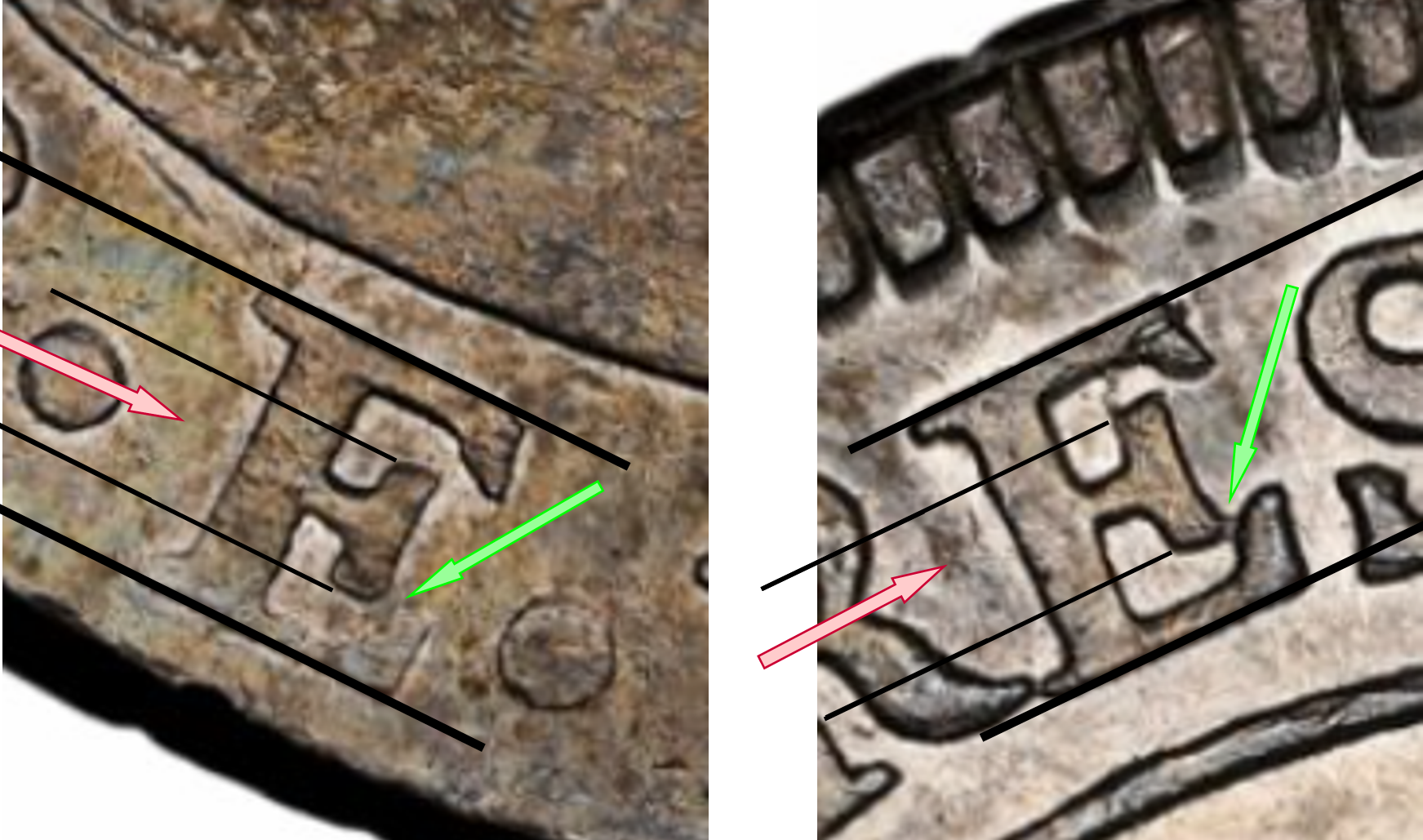
I agree with this.
I agree with this.
I agree that certainly seems to be the case.
The E coins show various degrees of the mentioned tooling while the bottom F coin doesn't show any tooling
This is where I'm getting confused. If the Mystery coin matches the die characteristics of the E coin, and it has evidence of the tooling, albeit less evidence of the tooling is visible on the second coin it is visible on other E coins, and it displays the die crack of the E coin in the E of "CRESCA" and the F coin does not, how is it that, with all the evidence pointing to an E coin, are you saying it must be an F coin. Wouldn't it be an E coin with a different Assayer stamp for some unknown reason?
To be clear, I'm not looking to come off as being confrontational in anyway, I'm just honestly confused and trying to understand.
*Edited out Horizontal, as I meant Vertical, regarding the part of central leg of the E
@JohnnyCache I believe what @Rexford is saying is that this reverse die started its life with an F assayer letter. It struck CR F coins in 1831. Later on (1838+ per MrEureka) the F was recut into an E and more coins were struck with this reverse die under “Mr E”, the new assayer.
Please correct if I have that wrong.
It's an interesting hypothesis. Too bad there hasn't been a single image of a fully struck example of the F die that would match this ambiguous one. How likely is the mint striking a handful of coins with an F assayer none of which survived fully struck, and that die later reworked into an E die so perfectly that none of the under-type remained visible?
None of these coins are mine. And I already have a nice 31-E and 31-F, so it really doesn’t matter to me what they sell for. Finally, I’m not convinced that getting the mystery coin into a 31-E holder adds value. Sure, the 31-E is much rarer, but the 31-F is rarer in MS. Furthermore, a 31-E that looks like a 31-F is kind of a white elephant. All that said, I like this series and I just want to get it right.
Doggedly collecting coins of the Central American Republic.
Visit the Society of US Pattern Collectors at USPatterns.com.
Sure, I can get on board with that - but it’s more similar to the Es than the letter on the top coin. For instance, the middle bar curves instead of having sharp corners like on the Fs. By 1838 it’s likely a different E punch was being used, so that makes sense if it was repunched.
That’s correct. Apologies if this was not stated clearly in my initial comments.
Gobrecht's Engraved Mature Head Large Cent Model
https://www.instagram.com/rexrarities/?hl=en
@MrEureka @TwoKopeiki
This coin with assayer F seems to show the start of the die crack in the E of cresca, the spacing of the "RE" in the legend of cresca and the tooling over the zero of 10
So it does. Spacing is of course the same as well. Good find.
Well…there it is. I’m sure it happens much more frequently than one might think - one generally only knows of the overdates, overassayers, and other repunches that are visibly obvious. Fill in the letter or digit and then smooth it out cleanly enough before repunching, and it will be gone. Or possibly the E just fully covered the outline of the F.
Gobrecht's Engraved Mature Head Large Cent Model
https://www.instagram.com/rexrarities/?hl=en
This coin checks all the boxes! F it is. Exceptional claims, exceptional research, exceptional evidence. Thanks, this was fun.
So I did a workup on this coin in question as an exercise some months back sort of piggybacking off the other thread focused on the 1831-CR 8R - mainly discussing undertypes and Cent Amer Rep contemporary counterfeits vs. modern fabrications:
https://forums.collectors.com/discussion/1104773/central-american-republic-1831-for-costa-rica
In a brief message exchange, I was told by a member here, with no further elaboration, that the cutoff assayer piece discussed in this thread "was called a CR-E for many years... that was corrected recently." If said member is reading and is in a position to add anything, would be interesting to hear, but that might be privileged. Said member knows his stuff, so good enough for me to duly note as-is.
Nevertheless, out of curiosity, I started looking through a bunch of CR examples, including every "E" I could find. Looking back, I had my conclusion backwards. Most of this is redundant now as this discussion has worked through it, but just to reiterate AND add a different insight:
Long story short, all (5) assayer E pieces I saw in readily searchable archives (note the assayer E in this upcoming auction is one of the 5)... the cutoff assayer piece being discussed... and the assayer F piece @JohnnyCache posted just above ARE definitively all various stages of the same reverse die. Multiple die markers, legend positioning... zero doubt. I believe I did a quick runthrough of EVERY 1831 CR-F I could find, looking for the spit coming out of E in CRESCA (and maybe also casually for the diagonal line marker above the 0 in "10 Ds"), and did not catch any other assayer F examples besides that single piece (I could be imperfect on that, pic quality varies, etc.).
Beyond that, yes, the assayer F piece from the same die proves the "original" must have been, in fact, assayer F. That spit coming out of the upper R in CRESCA is clearly very short on that piece... but is longer/more pronounced (fully a visible "die crack") on a few of the assayer E pieces. Thus the assayer E version must be the later one.
I won't add to the other reverse die analysis seen above... based on everything seen, solely looking at the reverse die, agreed that the cutoff assayer piece is almost certainly from the assayer F iteration of that reverse die.
Now, I do note in doing CTRL + F on this page that the word "obverse" oddly yields zero results. Compare the OBVERSE dies on the confirmed assayer F example, the cutoff assayer piece, and the assayer E pieces in archives... ALL (5) assayer E pieces in archives show a distinct die crack by the date area on the obverse/sunburst side - clearly the same die.
The cut-off assayer piece does NOT have that crack and the 8 is positioned differently - definitively a different obv die. Same is true for the assayer F piece with that reverse die... Comparing those two coins' obverses closely, not a heck of a lot to go in terms of matching markers and positioning, BUT... between that distinctly right-tilting 8 in the date and also a tiny little matching die chip on the right side of the dot to the right of the date, fairly confident those (2) pcs. ARE in fact the same obverse die.
I haven't done much further comparison on the obverses because even I'm not that bored. I don't know if the obverse die with the right-tilting 8 noted above is found paired with any other different assayer F reverses... I HAVE, however, seen at least one definite example of the obverse found paired with the assayer E reverse... paired with a DIFFERENT assayer F reverse die:
https://www.acsearch.info/search.html?id=4495853
Links to the other pieces for quick reference:
assayer F with same rev die as "E" pieces:
https://auctions.stacksbowers.com/lots/view/3-13WGIZ/costa-rica-central-american-republic-8-reales-1831-cr-f-san-jose-mint-pcgs-au-50
cut-off assayer:
https://coins.ha.com/itm/costa-rica/8r-1831cr-f-ms63-ngc-/p/3125-11013.s?ic4=ListView-ShortDescription-071515#
Assayer E pieces:
https://coins.ha.com/itm/costa-rica/costa-rica-central-american-republic-8-reales-1831-cr-e-vf-/a/231613-65124.s?ic4=ListView-ShortDescription-071515#
https://coins.ha.com/itm/costa-rica/costa-rica-central-american-republic-8-reales-1831-cr-e-vf30-ngc-/a/3046-29661.s?ic4=ListView-ShortDescription-071515#
https://coins.ha.com/itm/costa-rica/costa-rica-central-american-republic-8-reales-1831-cr-e-au53-ngc-/a/3044-31140.s?ic4=ListView-ShortDescription-071515
https://coins.ha.com/itm/costa-rica/central-american-republic-8-reales-1831-cr-f-ms61-ngc-/p/3125-11012.s?ic4=ListView-ShortDescription-071515
https://auctions.stacksbowers.com/lots/view/1-1JT22/costa-rica-8-reales-1831-cre-ngc-ef-45
Two questions:
-- Does anyone have good pics of any additional assayer E examples besides the (5) I noted?
-- @MrEureka, you might be best for this... but anyone, would there have been any possibility of any type of die sharing/muling with NG mint 8R dies - most specifically 1831 NG obverses????
Yes they do seem to match up
shown here with 3 varying degrees of transparency